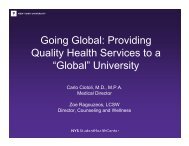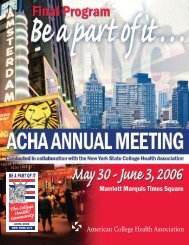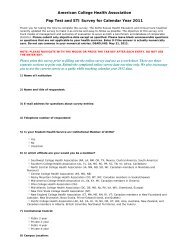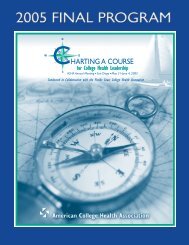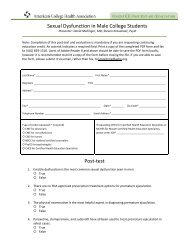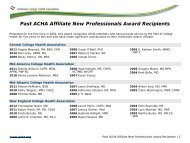Stimulant Misuse: Strategies to Manage a Growing Problem (.pdf)
Stimulant Misuse: Strategies to Manage a Growing Problem (.pdf)
Stimulant Misuse: Strategies to Manage a Growing Problem (.pdf)
- No tags were found...
You also want an ePaper? Increase the reach of your titles
YUMPU automatically turns print PDFs into web optimized ePapers that Google loves.
altered. 42 Longer-acting formulations may obviate the need for<br />
students with ADHD <strong>to</strong> bring their medications <strong>to</strong> school.<br />
One long-acting methylphenidate product, osmotically-controlled<br />
release oral delivery system methylphenidate, has the<br />
added advantage of being formulated such that it is difficult <strong>to</strong><br />
tamper with or alter the medication for nasal or intravenous<br />
abuse. 9,28,41<br />
Recognizing the Student Who <strong>Misuse</strong>s<br />
<strong>Stimulant</strong>s<br />
Health centers should aim <strong>to</strong> balance the provision of services<br />
for students possessing an ADHD diagnosis with the ability<br />
<strong>to</strong> recognize students who are misusing stimulants. 18<br />
Students illicitly using stimulants may present with a variety<br />
of signs and symp<strong>to</strong>ms (Table 5).<br />
Clinicians should be aware that individuals<br />
who insist that only a large<br />
dose is effective may be diverting the<br />
drug for money or personal abuse.<br />
Unexplained clinical features that do<br />
not fit with previous health records<br />
should prompt suspicion for drug misuse<br />
activity as well. Demanding times<br />
within the academic year, such as during<br />
finals, may lead <strong>to</strong> increased<br />
demand for stimulants. More students<br />
than usual may visit health services<br />
presenting unexplained anxiety, irritability,<br />
excited speech, tachycardia,<br />
hypertension, and confusion. Students<br />
with various unexplained negative<br />
behaviors, such as extreme irritability,<br />
depression, or violence, may be involved with illicit substance<br />
abuse, and prescribing stimulants should be avoided<br />
as these students are at increased risk for the development of<br />
stimulant misuse, abuse, and dependence. 18,42<br />
Summary<br />
Although stimulants have shown safety and efficacy in managing<br />
the symp<strong>to</strong>ms of ADHD when taken in accordance with a<br />
clinician’s guidance, there exists a significant potential for misuse.<br />
School officials, health centers, and students all play an<br />
important role in the prevention of stimulant misuse. As a<br />
result, education on the proper use of stimulants and on the<br />
signs and symp<strong>to</strong>ms of misuse and the health risks associated<br />
with misuse is an imperative. ■<br />
Table 5. Signs and Symp<strong>to</strong>ms of <strong>Stimulant</strong> Abuse<br />
• Anxiety and excited speech (may look like an acute panic attack)<br />
• Anorexia (can be severe)<br />
• Confusion<br />
• Depression<br />
• Increased pulse rate (tachycardia) and blood pressure (even overt hypertension)<br />
• Increased wakefulness and physical activity<br />
• Irritability<br />
• Infections from intravenous drug use (endocarditis, hepatitis, HIV, others)<br />
• Memory loss<br />
• Paranoia and aggressive tendency (even violent behavior)<br />
• Profound insistence on prescription refill<br />
• Psychosis<br />
• Tremors and convulsions<br />
• Worsening academic performance<br />
References<br />
1. Greydanus DE, Pratt HD. Attention-deficit/hyperactivity disorder in adolescents.<br />
In: Greydanus DE, Patel DR, Pratt HD, eds. Essentials of Adolescent<br />
Medicine. New York, NY: McGraw-Hill Medical Publishers; 2006:751-768.<br />
2. Reiff MI, Stein MT. Attention-deficit/hyperactivity disorder evaluation<br />
and diagnosis: a practical approach in office practice. Pediatr Clin North<br />
Am. 2003;50(5):1019-1048.<br />
3. DEA Briefs & Background, Drugs and Drug Abuse, Drugs Descriptions,<br />
Methylphenidate. Available at: http://www.dea.gov/concern/methylpheni<br />
date.html. Accessed December 1, 2005.<br />
4. NIDA-Information on Drugs of Abuse-Prescription Drug Abuse Chart.<br />
Available at: http://www.drugabuse.gov/DrugPages/PrescripDrugsChart.<br />
html. Accessed February 10, 2006.<br />
5. Staufer WB, Greydanus DE. Attention-deficit/hyperactivity disorder psychopharmacology<br />
for college students. Pediatr Clin North Am. 2005;<br />
52(1):71-84.<br />
6. Luna GC. Use and abuse of amphetamine-type stimulants in the United<br />
States. Pan Am J Public Health. 2001;9:114-122.<br />
7. Ellinwood E, King G, Lee T. Chronic amphetamine use and abuse.<br />
Available at: www.acnp.org/g4/GN401000166/CH162.htm. Accessed<br />
February 17, 2006.<br />
8. Murray JB. Psychophysiological aspects of amphetamine-methamphetamine<br />
abuse. J Psychol. 1998;132:227-237.<br />
9. Greydanus DE, Patel DR. The adolescent and substance abuse: current<br />
concepts. Disease-a-Month. 2005;51(7):387-432.<br />
10. Upadhyaya HP, Rose K, Wang W, et al. Attention-deficit/hyperactivity disorder,<br />
medication treatment, and substance use patterns among adolescents<br />
and young adults. J Child Adolesc Psychopharmacol. 2005;15(5):799-809.<br />
11. American Psychiatric Association. Diagnostic and Statistical Manual of<br />
Mental Disorders, Fourth Edition, Text Revision (DSM-IV-TR). Washing<strong>to</strong>n,<br />
DC: American Psychiatric Publishing; 2000:175-191.<br />
12. Barrett SP, Darredeau C, Bordy LE, et al. Characteristics of methylphenidate<br />
misuse in a university student sample. Can J Psychiatry. 2005;<br />
50:457-461.<br />
13. Kollins SH, MacDonald EK, Rush CR. Assessing the abuse potential of<br />
methylphenidate in nonhuman and human subjects: a review. Pharmacol<br />
Biochem Behav. 2001;68:611-627.<br />
14. Sallee FR, Gill HS. Neuropsychopharmacology III: psychostimulants. In:<br />
Coffey CE, Brumback RA, eds. Textbook of Pediatric Neuropsychiatry.<br />
Washing<strong>to</strong>n, DC: American Psychiatric Press; 1998:1351-1372.<br />
15. Kapner DA. Infofacts resources: recreational use of Ritalin on college campuses.<br />
Available at: http://www.edc.org/hec/pubs/factsheets/ritalin.html.<br />
Accessed September 15, 2005.<br />
16. Greydanus DE, Sloane MA, Rappley MD. Psychopharmacology of ADHD<br />
in adolescents. Adolesc Med. 2002;13:599-624.<br />
22<br />
ACHA PROFESSIONAL DEVELOPMENT PROGRAM


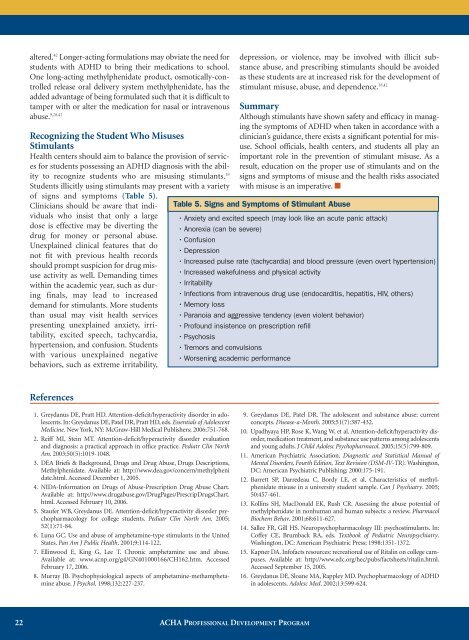
![Final Program [5.4MB pdf] - American College Health Association](https://img.yumpu.com/49022356/1/190x245/final-program-54mb-pdf-american-college-health-association.jpg?quality=85)


